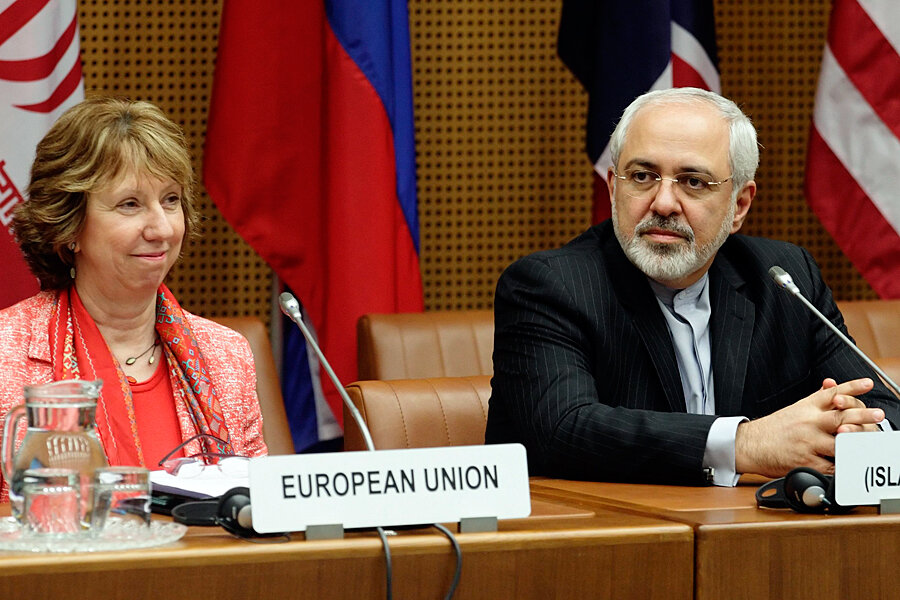What will an Iranian nuclear deal look like? Here's one option.
| Tehran, Iran
There has been no shortage of reports on the Iranian nuclear standoff. But among the most useful and timely is a report today by the International Crisis Group (ICG) that provides a blueprint for how a final nuclear deal can be reached. It comes only days before Iran and six world powers meet for a fourth time, with the July 20 deadline to conclude a deal looming.
Like negotiators, the Brussels-based ICG's report is playing the long game. Its timeline stretches out for as much as 19 years, acknowledging that for a deal to stick, the parties will have to overcome decades of mistrust with years of demonstrated goodwill – or at least joint adherence to a deal.
The report includes a detailed technical discussion of how to ensure that Iran will never be able to produce a nuclear weapon. But what sets it apart is that it takes into account the political hurdles, which have proven to be the most difficult issue to resolve, as well as the view from Iran.
Most previous proposals have been “American-centric,” and too focused on individual elements of a deal, says Ali Vaez, the senior Iran analyst for ICG, who has close contacts with both US and Iranian officials. But this report is “based on feedback from both parties to help the negotiators, beholden as they are to their respective national narrative and political constraints," Mr. Vaez says.
It presents middle-ground solutions to the thorniest issues, like limiting Iran’s uranium enrichment capacity and how the P5+1 group (the US, Russia, China, Britain, France, and Germany) should rollback sanctions.
“These proposals have not been developed to fully satisfy one party, but rather pave the ground for a win-win solution,” Vaez says.
Carefully choreographed to ensure reciprocal and mutually reassuring steps, the ICG roadmap includes the following provisions:
- Measurement of Iran’s enrichment capacity not in the number of centrifuges but by their overall output, allowing Iran to choose its own configurations as long as they remain within agreed parameters.
- An initial one or two year capping of Iranian enrichment capacity just below what it is today, at roughly 8,000 operating centrifuges. After years of trust building – including intrusive transparency measures and a “zero stockpile” policy of immediately converting enriched uranium into fuel that has no military use – Iran would be allowed to expand that capacity threefold, to the equivalent of roughly 24,000 of its first-generation centrifuges.
- Modification of the Arak heavy water reactor – which concerns the P5+1 because the plutonium it will produce when complete could be another path to a bomb – to produce a fraction of the amount of plutonium.
- The establishment of an objective and compulsory mechanism for mediating disputes
In return, Iran would be granted:
- No shutdown of the underground Fordow facility, as once demanded by the P5+1. It would be converted to a research and development facility, with strict limits.
- The lifting of sanctions throughout the process in rapid bursts after "significant preparation time." The report describes this as a "front-loading of the agreement to rally support."
- The release, after the first year or two, of half of Iran’s frozen oil revenue, as well as the lifting of many restrictions on Iranian banking. The EU would gradually resume oil imports. The remaining funds would be released, and more sanctions lifted, in the next five to seven years.
- The provision of technical expertise to its civilian nuclear program
- The removal of remaining nuclear-related sanctions on the gas and oil sector in the last phase of the deal.
Such a deal might not square with expectations of some in the US Congress, who want Iran to be left with no more than a symbolic few thousand centrifuges. They will not welcome a deal that leaves Iran with a substantial nuclear infrastructure.
Nor will it play well with hardliners in Iran, who believe that Iran was “ripped off” by the first-step Geneva agreement reached last November, in which Iran halted its nuclear advances and removed the stockpiles of its most sensitive enriched material in exchange for modest sanctions relief.
Both of those parties have threatened to derail the nuclear negotiations with bellicose statements that elicited angry reactions from the other side.
"The parties’ misperceptions and faulty expectations have rendered them prone to overreaching,” notes the report. “All will need to beware, in selling the agreement, not to encourage the other side’s hardliners through belligerent rhetoric or by crowing over an ostensible victory.”







